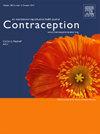产后立即使用注射避孕药对母乳喂养的影响
IF 2.8
2区 医学
Q1 OBSTETRICS & GYNECOLOGY
引用次数: 0
摘要
目标 美国的指南允许打算用母乳喂养婴儿的人使用醋酸甲羟孕酮去甲肾上腺素(DMPA)。然而,由于缺乏高质量的证据,DMPA 的使用在实践中往往受到限制。我们评估了产后立即使用DMPA对泌乳发生第二阶段(LS=II)时间的影响。方法最初的设计是随机分配在2019-2021年分娩足月婴儿的成人,让他们在分娩后48小时内接受DMPA、安慰剂注射,或在分娩后48小时内接受DMPA注射:DMPA、安慰剂注射或不注射。由于注册人数较少,我们在 2021-2023 年改为非随机设计,使用倾向得分加权进行分析,并平衡肥胖和分娩方式的招募。在此,我们综合了两种设计的数据,对产后立即使用 DMPA(55 人)与对照组(95 人)进行了比较。结果在未加权分析中,DMPA组到LS-II的平均时间为57.8小时(SD=29.4),对照组为64.1小时(SD=36.1)。利用倾向得分加权法使两组在年龄、种族和孕产期方面具有可比性,我们发现 DMPA 组妇女的 LS-II 平均时间比对照组缩短了 5.4 小时(95% CI,-16.3,5.4)。我们的研究结果支持有意进行母乳喂养的妇女在产后立即使用 DMPA。本文章由计算机程序翻译,如有差异,请以英文原文为准。
EFFECTS OF IMMEDIATE POSTPARTUM USE OF INJECTABLE CONTRACEPTION ON HUMAN MILK FEEDING
Objectives
US guidelines permit depot medroxyprogesterone acetate (DMPA) use among people intending to feed their infant with their milk. However, DMPA use is often restricted in practice due to lack of high-quality evidence. We evaluated the effect of immediate postpartum DMPA use on the timing of lactogenesis stage-II (LS=II).
Methods
The initial design randomly assigned adults who delivered a full-term infant in 2019-2021 to receive within 48 hours of delivery: DMPA, placebo injection, or no injection. Due to low enrollment, we changed in 2021-2023 to a non-randomized design using propensity score weighting for analysis and balancing recruitment for obesity and delivery method. Here, we combined data from both designs to compare immediate postpartum DMPA use (n=55) vs. control arm (n=95). We defined noninferiority a priori as being met if the upper bound of a two-sided 95% confidence interval (CI) for the mean difference in time to LS-II between the immediate DMPA and control groups was <6 hours.
Results
In the unweighted analysis, the mean time to LS-II was 57.8 hours in the DMPA arm (SD=29.4) and 64.1 hours in the control arm (SD=36.1). Using propensity score weighting to make the arms comparable with respect to age, race, and gravidity, we found that the mean time to LS-II was 5.4 hours shorter (95% CI, -16.3, 5.4) for women in the DMPA relative to control arm.
Conclusions
We found no evidence that DMPA use inhibits the initiation of LS-II. Our findings support the immediate postpartum use of DMPA among those intending to engage in human milk feeding.
求助全文
通过发布文献求助,成功后即可免费获取论文全文。
去求助
来源期刊

Contraception
医学-妇产科学
CiteScore
4.70
自引率
17.20%
发文量
211
审稿时长
69 days
期刊介绍:
Contraception has an open access mirror journal Contraception: X, sharing the same aims and scope, editorial team, submission system and rigorous peer review.
The journal Contraception wishes to advance reproductive health through the rapid publication of the best and most interesting new scholarship regarding contraception and related fields such as abortion. The journal welcomes manuscripts from investigators working in the laboratory, clinical and social sciences, as well as public health and health professions education.
 求助内容:
求助内容: 应助结果提醒方式:
应助结果提醒方式:


